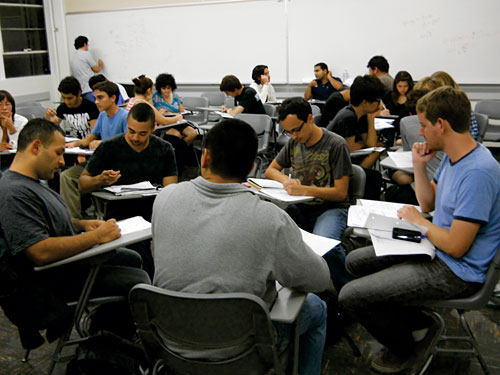Bridge programs boost PhD enrollment among underrepresented minorities
DOI: 10.1063/PT.3.2511
This academic year, the physics departments at Florida State University (FSU) and California State University, Long Beach become the latest sites to offer underrepresented minorities in the US a sound preparation for a PhD in physics via so-called bridge programs (see Physics Today, March 2011, page 30
At each site, two recent college graduates a year are supported at the master’s or early PhD level; when they can, host institutions pitch in to support additional students. The amount of APS funding varies by institution but goes mainly toward student stipends and for the students and program leaders to attend a bridge conference hosted by APS. The aim is for the programs to continue beyond their three years of APS sponsorship.
“We take care of all our students, but we will look more carefully at these two [bridge students],” says Andreas Bill, a bridge site leader at Cal State Long Beach, where the master’s is the highest degree awarded in physics and applied physics and where minorities make up about 40% of the student body. At FSU, the first bridge students started this summer with research internships at the National High Magnetic Field Laboratory in Tallahassee.

An annual, two-day boot camp at California State University, Long Beach helps students build confidence and improve their performance on the Graduate Record Examination. Such activities, aimed at demonstrating a commitment to diversity, are typical for sites that the American Physical Society selects for its bridge program.
ANDREAS BILL/CAL STATE LONG BEACH

The bridge sites seek students already interested in pursuing a PhD: APS program officials ask universities to recommend the bridge program to underrepresented minority applicants who did not gain admission to a PhD program. APS also shares the applications with the bridge programs, including the country’s four other, more established and broader ones—at MIT, Fisk–Vanderbilt, Columbia University, and the University of Michigan. Simon Capstick, FSU bridge site leader, says his department looked at 38 such shared applications “and there were 6 or 7 we would have accepted in a heartbeat. Next year we will hold spots in reserve.”
The overall aim of the APS bridge program “is to increase the numbers of underrepresented students who get PhDs in physics,” says program manager Brian Beckford. In the US, he says, slightly less than 10% of physics bachelor’s degrees go to underrepresented minority students. At the PhD level, it’s no more than 6%. “If we can increase that to 10%, that would be a measure of success,” he says. “And because the numbers are so small, that represents about 30 more students a year.”
The efforts seem to be paying off: Six of the first cohort of eight APS bridge students are continuing on at their respective universities, Beckford says. And this fall, in addition to the 11 incoming bridge students at APS sites, 14 underrepresented minority students from among those who initially didn’t gain spots for doctoral studies are entering graduate physics programs thanks to APS’s having sent around their applications. The bridge programs, and APS’s attention to underrepresented minority applicants to graduate school, says Capstick, have “grown into a way to get students who would otherwise have fallen through the cracks.”
Now, APS is planning to form partnerships with physics departments that are committed to increasing diversity. “It will show students that a particular university is a good place to go,” says Beckford. “They may get a little more focused attention, early intervention, and mentoring.”
More about the Authors
Toni Feder. tfeder@aip.org





